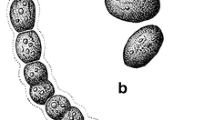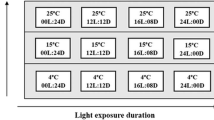Abstract
A special cluster of filamentous, false-branched cyanobacteria, isolated from littoral mat samples in coastal lakes of the Larsemann Hills region (coll. by D. Hodgson) was studied by a polyphasic approach. This morphotype has several characters corresponding to the traditional genera Leptolyngbya (morphology of trichomes), Pseudophormidium (type of false branching) or Schizothrix (occasional multiple arrangement of trichomes in the sheaths). However, this cluster of strains is distinctly isolated according to its phylogenetic position (based on 16S rRNA gene sequences), and thus, a separate generic classification is justified. The cytomorphology of this generic entity is also characteristic. Therefore, a new genus (Plectolyngbya with the type species P. hodgsonii) was described. The same cyanobacterial morphotype was found in the littoral zone of the partially frozen inland Monolith Lake in the northern, deglaciated area of James Ross Island, in the NW part of the Weddell Sea. Plectolyngbya hodgsonii occurs evidently in more Antarctic lakes of the continental type, under very particular conditions (littoral with average temperature below 3°C during the Antarctic summer season, with periodical drying and freezing for more than 8 months in a year). The valid definition, phenotype documentation and ultrastructural characters of this cyanobacterium are presented in this article. Morphologically (and possibly genetically) similar types are common in other habitats in various regions and represent probably different species.






Similar content being viewed by others
References
Anagnostidis K, Komárek J (1988) Modern approach to the classification system of cyanophytes 3—Oscillatoriales. Algolog Stud 50–53:327–472
Bischoff HW, Bold HC (1963) Phycol stud IV. Some soil algae from enchanted rock and related algal species. Austin Univ Texas Publ 6318:1–95
Elhai J, Taton A, Massar JP, Myers JK, Travers M, Casey J, Slupesky M, Shrager J (2009) BioBIKE: a web-based, programmable, integrated biological knowledge base. Nucleic Acids Res 37:W28–W32
Felsenstein J (1989) PHYLIP—phylogeny inference package (Version 3.2). Cladistics 5:164–166
Gordon DA, Priscu JC, Giovannoni S (2000) Origin and phylogeny of microbes living in permanent Antarctic lake ice. Microb Ecol 39:197–202
Greuter W, McNeill J, Barrie FR, Burdet H-M, Demoulin V, Filgueiras TS, Nicholson DH, Silva PC, Skog JE, Trehane P, Turland NJ, Hawksworth DL (eds) (2000) International code of botanical nomenclature (St Louis code), adopted by the sixteenth international botanical congress, St. Louis, Missouri, July–August 1999. Koeltz Scientific Books, Königstein
Guindon S, Gascuel O (2003) A simple, fast, and accurate algorithm to estimate large phylogenies by maximum likelihood. Syst Biol 52:696–704
Karnovsky MJ (1965) A formaldehyde-glutaraldehyde fixative of high osmolality for use in electron microscopy. J Cell Biol 27:137A–138A
Kellenberger E, Ryter A, Séchaud J (1958) Electron microscope study of DNA-containing plasms. II. Vegetative and mature phage DNA as compared with normal bacterial nucleoids in different physiological states. J Biophys Biochem Cy 4:671–678
Komárek J (1999) Diversity of cyanoprokaryotes (cyanobacteria) of King George Island, maritime Antarctica—a survey. Algolog Stud 94:181–193
Komárek J, Anagnostidis K (2005) Cyanoprokaryota -2. Teil/2nd part: Oscillatoriales. In: Büdel B, Krienitz L, Gärtner G, Schagerl M (eds) Süsswasserflora von Mitteleuropa 19/2. Elsevier/Spektrum, Heidelberg
Komárek J, Komárek O (2003) Diversity of cyanobacteria in seepages of King George Island, maritime Antarctica. In: Huiskes AHL et al (eds) Antarctic biology in a global context. Proceedings VIIIth SCAR internat. symp. 2001, Amsterdam. Backhuys Publishers, Leiden, pp 244–250
Komárek J, Komárek O (2009) Specificity of cyanobacterial microflora in Antarctica. In: Barták M, Hájek J, Váczi P (eds) Structure and function of Antarctic terrestrial ecosystems, Brno, October 22–23rd 2009, pp 23–28
Komárek J, Elster J, Komárek O (2008) Diversity of the cyanobacterial microflora of the northern part of James Ross Island, NW Weddell Sea, Antarctica. Polar Biol 31:853–865
Lanave C, Preparata G, Saccone C, Serio G (1984) A new method for calculating evolutionary substitution rates. J Mol Evol 20:86–93
Ludwig W, Strunk O, Westram R, Richter L, Meier H, Yadhukumar BA, Lai T, Steppi S, Jobb G, Forster W, Brettske I, Gerber S, Ginhart AW, Gross O, Grumann S, Hermann S, Jost R, Konig A, Liss T, Lussmann R, May M, Nonhoff B, Reichel B, Strehlow R, Stamatakis A, Stuckmann N, Vilbig A, Lenke M, Ludwig T, Bode A, Schleifer KH (2004) ARB: a software environment for sequence data. Nucleic Acids Res 32:1363–1371
Nylander JAA (2004) MrAIC.pl. Program distributed by the author. Evolutionary Biology Centre, Uppsala University, Sweden
Priscu JC, Fritsen CH, Adams EE, Giovannoni SJ, Paerl HW, McKay CP, Doran PT, Gordon DA, Lanoil BD, Pinckney JL (1998) Perennial Antarctic lake ice: an oasis for life in polar desert. Science 280:2095–2098
Pruesse E, Quast C, Knittel K, Fuchs B, Ludwig W, Peplies J, Glöckner FO (2007) SILVA: a comprehensive online resource for quality checked and aligned ribosomal RNA sequence data compatible with ARB. Nucleic Acids Res 35:7188–7196
Rippka R, Deruelles J, Waterbury JB, Herdman M, Stanier RY (1979) Generic assignments, strain histories and properties of pure cultures of cyanobacteria. J Gen Microbiol 111:1–61
Sabbe K, Hodgson DA, Verleyen E, Taton A, Wilmotte A, Vanhoutte K, Vyverman W (2004) Salinity, depth and the structure and composition of microbial mats in continental Antarctic lakes. Freshwater Biol 49:296–319
Schmidt HA, Strimmer K, Vingron M, von Haeseler A (2002) TREE-PUZZLE: maximum likelihood phylogenetic analysis using quartets and parallel computing. Bioinformatics 18:502–504
Stackebrandt E, Goebel BM (1994) Taxonomic note: a place for DNA–DNA reassociation and 16S rRNA sequence analysis in the present species definition in bacteriology. Int J Syst Bacteriol 44:846–849
Staub R (1961) Untersuchungen an der Blaualge Oscillatoria rubescens DC. Schweiz Z Hydrol 23:83–198
Strimmer K, von Haeseler A (1996) Quartet puzzling: a quartet maximum likelihood method for reconstructing tree topologies. Mol Biol Evol 13:964–969
Taton A, Grubisic S, Ertz D, Hodgson DA, Piccardi R, Biondi N, Tredici MR, Mainini M, Losi D, Marinelli F, Wilmotte A (2006) Polyphasic study of Antarctic cyanobacterial strains. J Phycol 42:1257–1270
Vincent WF, Bowman JP, Rankin LM, McMeekin TA (2000) Phylogenetic diversity of picocyanobacteria in Arctic and Antarctic ecosystems. In: Bell R, Brylinski CM, Johnson-Green M (eds) Microbial biosystems: new frontiers. Proceedings of international symposium on microbial ecology, Halifax, Canada, pp 317–322
Acknowledgments
The authors thank Dominic Hodgson (British Antarctic Survey, Cambridge, UK) for providing the Antarctic material. They are indebted also to Dobromila Klemová and to Ladislav Ilkovics for their skilled assistance in electron microscopy and Dana Švehlová for technical assistance. The paper was prepared in the frame of grant supports of grant agencies of the Czech Republic GACR 206/05/0253, AV0Z60050516, a travel grant of the Czech Academy of Sciences/FNRS (1247) and the bilateral co-operation Wallonie-Bruxelles International (WBI)/Czech Republic. A. Wilmotte is research associate of the FRS-FNRS (Funds for Scientific Research) of Belgium and benefited from the FNRS Credit 1.5104.04. A. Taton had a FRIA fellowship.
Author information
Authors and Affiliations
Corresponding author
Rights and permissions
About this article
Cite this article
Taton, A., Wilmotte, A., Šmarda, J. et al. Plectolyngbya hodgsonii: a novel filamentous cyanobacterium from Antarctic lakes. Polar Biol 34, 181–191 (2011). https://doi.org/10.1007/s00300-010-0868-y
Received:
Revised:
Accepted:
Published:
Issue Date:
DOI: https://doi.org/10.1007/s00300-010-0868-y




